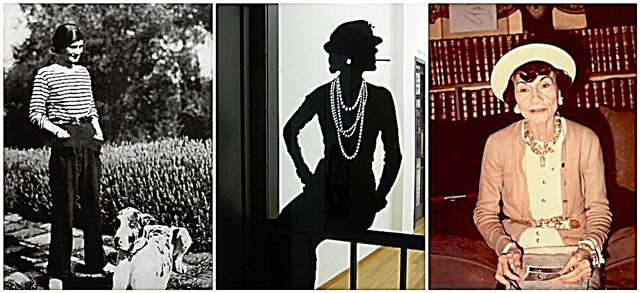Share
Pin
Tweet
Send
Share
Send
Ten great designers, thirty stylish coats - all that is needed for inspiration to those who love the history of fashion and want to bring a touch of elegant retro to their wardrobe!
About the fifties of the last century, many laudatory words have been said and written! This delightful era continues to inspire and delight anyone interested in fashion history.1950s clothing style
In our selection you will find the creations of ten famous designers of this decade, each of which will help to better understand and feel the “spirit of the time”. We hope that their ideas and stylistic decisions will inspire you to create your own masterpieces!
Cristobal Balenciaga

Photo: Balenciaga, collections of 1953, 1954 and 1952
The 50s are often called the era of Balenciaga, and Coco Chanel called him the only real couturier, next to whom all the rest are just designers.
Maestro is loved for its impeccable taste, strict cut, perfectly tuned lines, but its innovation can hardly be overestimated: a coat-rack, balloon skirts, voluminous capes, box hats, all this and much more has become an absolute classic of high fashion.
Cristobal Balenciaga: The Great Couturier
Christian Dior

Photo: Dior, collections of 1955, 1950 and 1959
Dior’s triumphant debut took place in 1947, and the 50s became the decade of no less triumphant procession of the New Look style in the hearts and wardrobes of fashionistas.
I'm a legend: Dior cardigan jacket
By the way, Cristobal Balenciaga considered Dior’s work with fabric simply “terrible” - not all contemporaries liked 30 kg evening dresses that could not be worn without help and in which it was not possible to dance!
- Special offer

- 1
- 2
- 3
- 4
Pierre Cardin

Photo: Pierre Cardin, 1959 and 1957 Collections
This no less famous designer began his journey with Christian Dior in 1947, but in 1950 founded his own fashion house. An avant-garde artist, experimenter, one of the pioneers of the unisex style, Carden was the first to start selling his work in a department store at prices affordable for mere mortals. For this insolence, he was expelled from the high fashion union, but, as subsequent history has shown, great changes often begin with insolence!
- Special offer

- 1
- 2
- 3
- 4
Pierre Balman

Photo: Balmain, collections 1959, 1957 and 1955
By the beginning of the fifties, Pierre Balmen already had a well-established name, and, as fashion historians say, it was he, even before Dior, who began to sew dresses with a narrow waist and a full skirt. It was he who owned the unusual and spectacular idea of creating entire evening sets: for each dress there was a cloak, a boa or a coat made of the same fabric and with a harmonious finish.
- Special offer

- 1
- 2
- 3
- 4
Madame gre

Photo: Madame Gres, 1953, 1956 and 1957 Collections
Madame Gre (née Germain Emily Krebs) was about to become a sculptor, but became one of the most distinctive and brilliant designers of her time. She cut without patterns, watching only how the fabric lays down - and she lay down with delightful antique draperies, which became the hallmark of images from Madame Gre!
- Special offer

- 1
- 2
- 3
- 4
Emil Hermes

Photo: Hermes, collections 1953, 1959 and 1954
Today, many people associate Hermes fashion house with famous silk scarves, but this was not always the case. Founded in 1837 as a workshop for the manufacture of equipment for crews and riding, this fashion house changed its assortment over time, starting to produce perfumes, ready-made clothes and numerous accessories. However, for more than half a century, the company’s logo remains an image of the harnessed crew - a reminder of the history of the brand’s foundation.
Jacques Fat

Photo: Jacques Fath, collections 1952 and 1954
Alas, the fifties became the sunset of the fashion house of the talented self-taught designer - in 1957 it was closed, three years after the death of Jacques Fat from leukemia. These last years, the house survived thanks to the efforts of the widow Fata. She presented her first collection in 1955, and critics praised her work.
Jeanne Lanven

Photo: Jeanne Lanvin, 1957 and 1958 Collections
She became famous at the beginning of the XX century thanks to the creation of models of elegant clothes for young mothers and their little daughters. As you might guess, the inspiration was her own young daughter, Marie Blanche.
After the death of her mother in 1946, Marie Blanche headed the fashion house, preserving the main features in it - a combination of sophisticated decoration, exquisite embroidery and light floral shades.
- Best-seller
- Special offer

- 1
- 2
- 3
- 4
Nina Ricci

Photo: Nina Ricci, 1959 and 1956 Collections
Founding a fashion house, Nina Ricci took as a basis feminine silhouettes with a narrow accentuated waist, graceful draperies and applications, as well as feminine romantic decor.
By the mid-50s, Ricci retired, giving complete freedom of action to her son Robert, and under his leadership the fashion house reached extraordinary heights.
- Special offer

- 1
- 2
- 3
- 4
Hubert Givenchy

Photo: Givenchy, collections 1959, 1956 and 1958
The real glory will come to the designer in the early 60s, but already in the fifties, the glory of the couturier was fixed for him, who wants to emphasize the individuality of each woman without overshadowing her. That is why a distinct elegant simplicity shines through in his models.
Givenchy learned a lot from Cristobal Balenciaga, who patronized the young designer. In addition, Givenchy was the first to start creating the pret-a-porte fashion, which went straight to stores.
24 winter coats that you will fall in love with
Share
Pin
Tweet
Send
Share
Send



